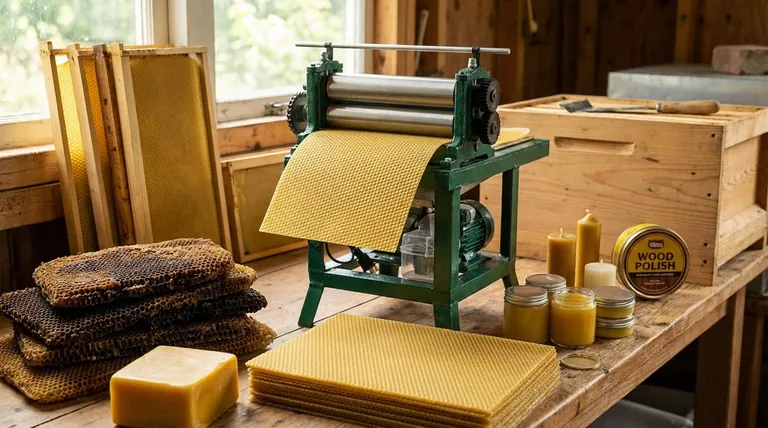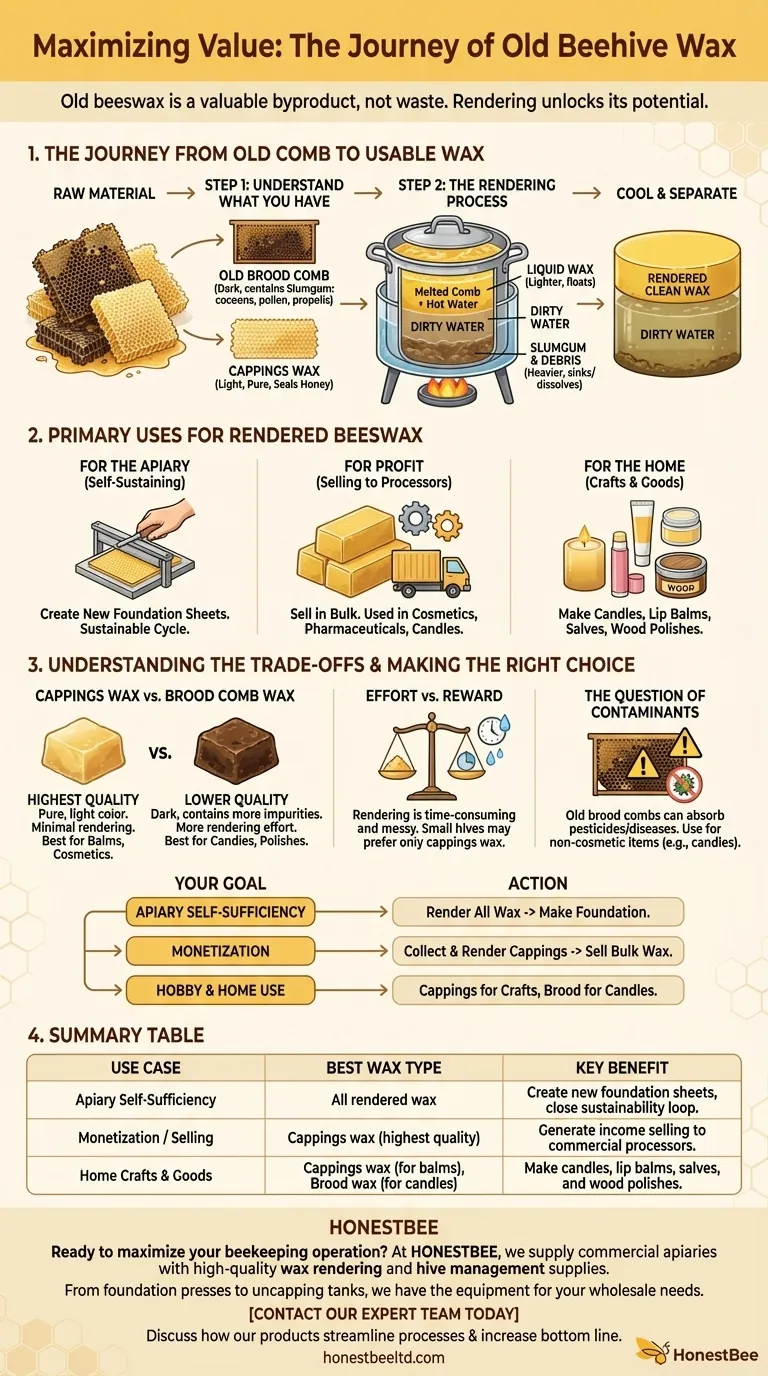First and foremost, old beeswax from a hive is a valuable byproduct, not waste. The most common path is to melt down the old combs and cappings to render raw, clean wax. This rendered beeswax can then be used to create new foundation for your own hives, sold to commercial wax processors, or used in a wide variety of household and craft projects.
The core challenge isn't deciding what to do with old beeswax, but rather understanding that it must first be rendered—a process of melting and filtering—to separate the pure wax from the hive debris and unlock its true value.

The Journey from Old Comb to Usable Wax
Before you can use old beeswax, you must process it. The dark, messy comb you pull from a hive is a raw material that needs refinement.
Step 1: Understanding What You Have
Old honeycomb, especially from the brood chamber, isn't just wax. It's a composite material containing honey residue, propolis, pollen, and layers of shed pupal cocoons from generations of baby bees. These cocoons are what make old brood comb dark and are often referred to as slumgum.
Step 2: The Rendering Process
Rendering is the simple but essential process of separating pure wax from these other materials. The basic principle involves melting the comb with hot water. Because wax is lighter than water and the debris, it will float to the top as it melts.
The debris and water-soluble materials either dissolve in the water or sink to the bottom. Once cooled, you are left with a solid cake of clean wax on top of the dirty water.
Primary Uses for Your Rendered Beeswax
Once you have a block of clean, rendered beeswax, you have several excellent options for its use.
For the Apiary: A Self-Sustaining System
The most traditional use for a beekeeper is to turn old wax back into new equipment. You can use a mold or press to create fresh foundation sheets. These sheets provide a guide for your bees, encouraging them to build straight, manageable comb in new frames and completing a sustainable cycle within your own apiary.
For Profit: Selling to Processors
If you produce a significant amount of wax, selling it can be a viable option. Commercial processors and large-scale candle makers buy beeswax in bulk. This wax is then used in a vast range of products, including cosmetics, pharmaceuticals, food-grade coatings, and high-end candles.
For the Home: Crafts and Goods
Even small amounts of rendered beeswax are perfect for high-value home and craft projects. The superior quality of beeswax makes it ideal for creating candles that burn brighter and cleaner than paraffin. It's also a key ingredient in natural lip balms, salves, lotions, and wood polishes.
Understanding the Trade-offs
While valuable, processing old wax involves considerations that every beekeeper should understand.
Cappings Wax vs. Brood Comb Wax
There is a significant difference in quality between wax sources. Cappings wax, the fresh wax bees use to seal honey cells, is the purest and most valuable. It's light in color and requires minimal rendering. In contrast, brood comb wax is dark, contains more impurities (slumgum), and yields less pure wax for the same amount of effort.
Effort vs. Reward
Rendering beeswax is a messy and time-consuming process. For beekeepers with only one or two hives, the small amount of wax recovered from old combs may not feel worth the significant cleanup required. In these cases, focusing only on the clean cappings wax may be a better use of your time.
The Question of Contaminants
Old combs, particularly from the brood chamber, can act as a sink for the hive. Over years, they can absorb agricultural pesticides from foraging environments or retain low levels of spores from bee diseases. While proper rendering and heat can mitigate some risk, many beekeepers prefer to use wax from old brood combs only for non-cosmetic uses, like fire-starters or candles, reserving pristine cappings wax for balms and lotions.
Making the Right Choice for Your Goal
Your decision on what to do with your old wax should align with your primary objective as a beekeeper.
- If your primary focus is apiary self-sufficiency: Render all your wax and invest in equipment to make your own foundation sheets.
- If your primary focus is monetization: Collect wax, especially cappings, and sell clean, rendered blocks to a commercial buyer or craft maker.
- If your primary focus is hobby and home use: Prioritize rendering your cleanest cappings wax for high-quality crafts like balms, and use the darker brood wax for candles or polishes.
Ultimately, viewing old comb as a resource rather than a problem transforms a cleanup task into a valuable opportunity.
Summary Table:
| Use Case | Best Wax Type | Key Benefit |
|---|---|---|
| Apiary Self-Sufficiency | All rendered wax | Create new foundation sheets, close the sustainability loop |
| Monetization / Selling | Cappings wax (highest quality) | Generate income by selling to commercial processors |
| Home Crafts & Goods | Cappings wax (for balms), Brood wax (for candles) | Make candles, lip balms, salves, and wood polishes |
Ready to maximize the value of your beekeeping operation?
At HONESTBEE, we supply commercial apiaries and beekeeping equipment distributors with the high-quality supplies needed for efficient wax rendering and hive management. From foundation presses to uncapping tanks, our wholesale-focused operations ensure you get the right equipment to turn your old wax into a profitable resource.
Contact our expert team today to discuss how our products can help you streamline your processes and increase your bottom line.
Visual Guide

Related Products
- Electric Beeswax Flat Sheet Machine with Operating Tray for Wax Processing
- Manual Beeswax Flat Sheet Machine for Beeswax Processing
- Electric Beeswax Foundation Machine With Operating Tray and Wax Foundation Roller
- Professional Thermostatic Conical Honey Melter
- Beehive Handle and Frame Rest Cutting Machine: Your Specialized Hive Machine
People Also Ask
- What is beeswax and why is it valuable? Discover Its Versatility for Your Business
- What is the process for purifying beeswax after removing it from a hive? A Simple Two-Stage Method for Pure Wax
- Why might a commercial beekeeper prefer an electric beeswax melter? Maximize Profit with Speed & Scale
- What are the steps involved in preparing wax sheets for milling? Master Temperature Control for Perfect Foundation
- How do worker bees produce beeswax? A Guide to the Hive's Manufacturing Process



















